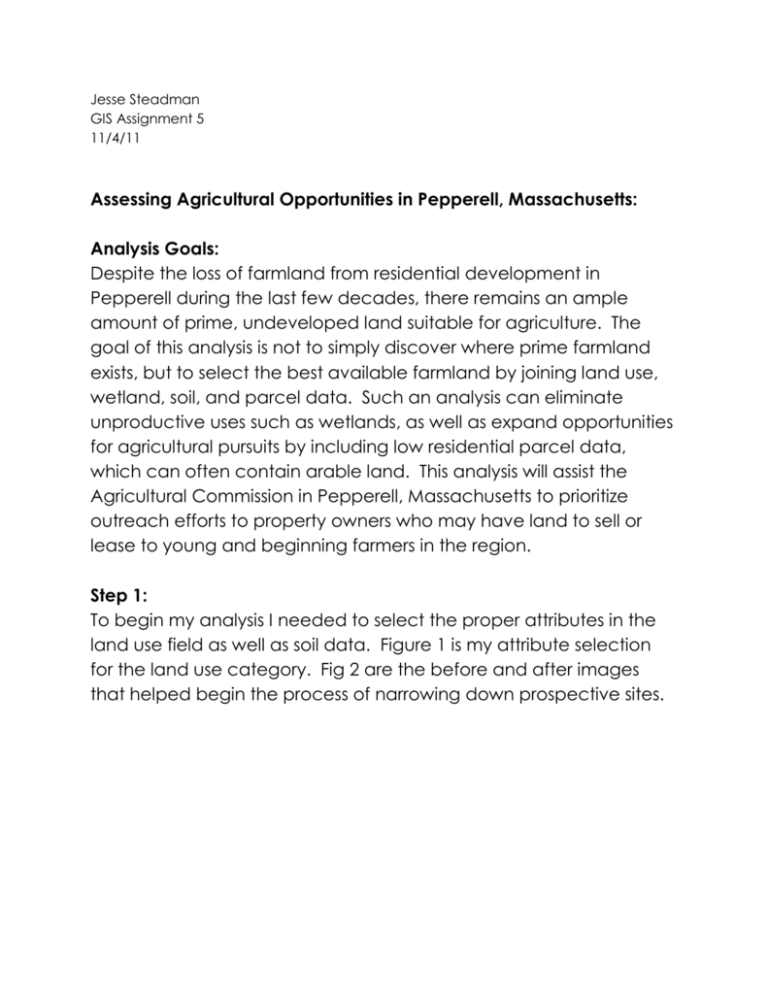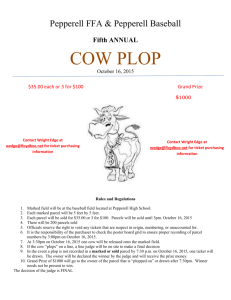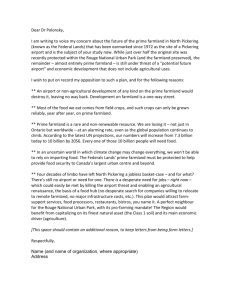GIS Assignment5
advertisement

Jesse Steadman GIS Assignment 5 11/4/11 Assessing Agricultural Opportunities in Pepperell, Massachusetts: Analysis Goals: Despite the loss of farmland from residential development in Pepperell during the last few decades, there remains an ample amount of prime, undeveloped land suitable for agriculture. The goal of this analysis is not to simply discover where prime farmland exists, but to select the best available farmland by joining land use, wetland, soil, and parcel data. Such an analysis can eliminate unproductive uses such as wetlands, as well as expand opportunities for agricultural pursuits by including low residential parcel data, which can often contain arable land. This analysis will assist the Agricultural Commission in Pepperell, Massachusetts to prioritize outreach efforts to property owners who may have land to sell or lease to young and beginning farmers in the region. Step 1: To begin my analysis I needed to select the proper attributes in the land use field as well as soil data. Figure 1 is my attribute selection for the land use category. Fig 2 are the before and after images that helped begin the process of narrowing down prospective sites. Fig. 2 Selected attributes Selected attributes after export Step 2: I performed the same task for soils data, selecting the “prime farmland” attribute from the “farmlandcl” category. Figure 3 shows the result of that selection. Fig. 3 Step 3: After selecting the data I needed for the land uses and soil data, I dissolved both sets of suitable data, as well as dissolved my wetlands layer. I then performed a union of these three layers which gave me a layer called Pepperell Suitable Management Units. Step 4: Adding a field: Fig 4: After adding the field I used the calculate geometry tab to give me the acreage of the acresMU field. Step 5: My statistics function tells me I have 163 parcels that contain prime farmland with a mean acreage 7.5. Fig. 5 Step 6: Selecting by location allowed me to view my management units by their proximity to a water source. Step 7: Summarize: Fig. 7 Summary Table: Fig. 8 The Summary table did not really give me the information I was expecting. I learned the total units that are within 1000 feet of a water source. But I was expecting to get the total acreage within that distance. Summary: I spotted an error within my data set that I was luckily able to correct. The Town of Pepperell uses what Mass GIS calls “level 0 parcel data.” Such data does not contain an attribute field for “fee” or “interest” which helps delineate real property in my analysis from data for sources such as roads. When I selected by location to water in this analysis, I realized that roads were also being used as a management unit. I used the info function and realized that all the roads had the same “objectID.” I simply used the select attribute function to remove that object ID from the select by location analysis. I am glad I saw it as the roads were skewing my acreage higher than it really was. Other than that things seem to be fairly sound with this data set. Of course, since 2005 land use data has almost certainly changed. Not to mention large properties probably underwent some parcelization or fragmentation due to subdivisions that were still rampant during the three years leading up to 2008. I would be interested to see an updated land use data set or even to see the data set against an up to date satellite photo.








